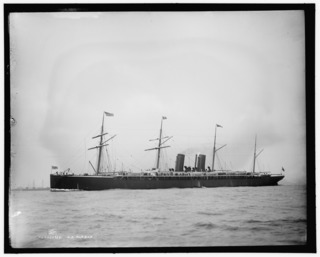
A steamship, often referred to as a steamer, is a type of steam-powered vessel, typically ocean-faring and seaworthy, that is propelled by one or more steam engines that typically move (turn) propellers or paddlewheels. The first steamships came into practical usage during the early 1800s; however, there were exceptions that came before. Steamships usually use the prefix designations of "PS" for paddle steamer or "SS" for screw steamer. As paddle steamers became less common, "SS" is assumed by many to stand for "steam ship". Ships powered by internal combustion engines use a prefix such as "MV" for motor vessel, so it is not correct to use "SS" for most modern vessels.

The New York Shipbuilding Corporation was an American shipbuilding company that operated from 1899 to 1968, ultimately completing more than 500 vessels for the U.S. Navy, the United States Merchant Marine, the United States Coast Guard, and other maritime concerns. At its peak during World War II, NYSB was the largest and most productive shipyard in the world. Its best-known vessels include the destroyer USS Reuben James (DD-245), the cruiser USS Indianapolis (CA-35), the aircraft carrier USS Kitty Hawk (CV-63), the nuclear-powered cargo ship NS Savannah, and a quartet of cargo-passenger liners nicknamed the Four Aces.
SS American Star may refer to:

The Grand Trunk steamship Prince Rupert and her sister ship SS Prince George served the coast of British Columbia and Alaska. Prince Rupert had a 45-year career serving northern ports from Vancouver, British Columbia, from 1910 to 1955. The ship was considered "unlucky" and suffered several incidents during her career, including two significant ones that left large portions of the vessel underwater. The ship was broken up in 1956.
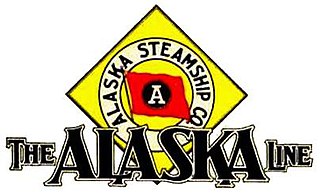
The Alaska Steamship Company was formed on August 3, 1894. While it originally set out to ship passengers and fishing products, the Alaska Steamship Company began shipping mining equipment, dog sleds, and cattle at the outbreak of the Klondike Gold Rush of 1897. The company was purchased by the Alaska Syndicate and merged with the Northwestern Steamship Company in 1909, but retained its name, and the fleet was expanded to 18 ships. During World War II, the government took over the company's ships. When the war ended, the company struggled to compete with the new Alaska Highway for passengers and freight. It discontinued passenger service altogether in 1954 and shut down operations in 1971.

The SS Princess Kathleen was a passenger and freight steamship owned and operated by Canadian Pacific Steamships. She served the coastal communities of British Columbia, Alaska and Washington.
SS America (1869–1872) was a ship for Pacific Mail Steamship Company operating on the China Line along with the SS Colorado, SS Great Republic, SS China, SS Alaska, SS Japan and spare steamer SS Herman. The America, which was one of the largest paddle wheel steamers in the world, was valued by Pacific Mail Steamship Company at $1,017,942 or about $40,000 less than the SS Great Republic or SS Japan.

SS Princess Mary was a passenger vessel in the coastal service fleet of the Canadian Pacific Railway (CPR) during the first half of the 20th century.

SS Olympia was a steamship that served the northwest United States and Alaska during the Klondike Gold Rush. She was wrecked in 1910.
SS Iowa was a steamship built by the Western Pipe and Steel Company of San Francisco, California in 1920 for the U.S. government and was known as the SS West Cadron. It served in the Quaker Line subsidiary of the States Steamship Co. from 1928—when it was renamed the Iowa—until January 12, 1936, when it encountered a gale and ran aground on Peacock Spit, Washington, part of the Columbia Bar at the mouth of the Columbia River. The Coast Guard cutter Onondaga was dispatched after an SOS was received at the Coast Guard station in Astoria, Oregon, but no survivors were found. All 34 people aboard the ship died, and only six bodies were recovered from the wreckage that dotted local shorelines for days.

The Pacific Coast Steamship Company was an important early shipping company that operated steamships on the west coast of North America. It was first organized in 1867 under the name Goodall, Nelson and Perkins. The Goodall, Nelson & Perkins Steamship Company was formed in 1875, but a year later was reorganized as the Pacific Coast Steamship Company. In 1916 the Admiral Line bought the shipping interests of the company.
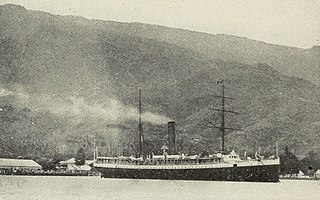
SS Mariposa was a steam cargo liner which served in the Pacific Ocean from 1883 to 1917.
SS Aleutian was a passenger ship in North American coastal service. Built in 1899 for the Ward Line as SS Havana, she would later serve the building of the Panama Canal as SS Panama and ultimately enter Alaskan service as SS Aleutian.

SS Oregon (1878–1906) was a coastal passenger/cargo ship constructed in Chester, Pennsylvania by the Delaware River Iron Ship Building and Engine Works in February 1878. Originally delivered to the Oregon Steamship Company, she was used on the Portland, Oregon-to-San Francisco, California route for many years. In 1879, the Oregon Railroad and Navigation Company became the Oregon′s new owners after purchasing the Oregon Steamship Company. Also included in this purchase were the steamships George W. Elder and City of Chester. While in O.R. & N service, Oregon served alongside SS Columbia, which made the first commercial use of Thomas Edison's incandescent light bulb. Like Oregon, Columbia was also built by John Roach & Sons in Chester, Pennsylvania. Over time, Oregon's hull became breached after a number of incidents. Furthermore, the hull had been weighted with concrete to the point where she was considered unsuitable for service as a passenger liner. After operating as a cargo ship, she was laid up in 1894 at Portland. In 1899, the Oregon was re-qualified to carry passengers once more. She was sold by O.R. & N the same year. Despite this, she was viewed as a cursed ship by her crew. The Oregon was owned by the White Star Steamship Company from around 1902 to 1905. Around this time, Oregon was operating between Alaska and Puget Sound.
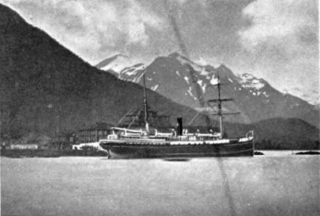
SS George W. Elder (1874–1935) was a passenger/cargo ship. Originally a U.S. east coast steamer, she was built by John Roach & Sons in Chester, Pennsylvania. The George W. Elder became a west coast steamer in 1876 and served with the Oregon Steamship Company, Oregon Railroad and Navigation Company, San Francisco and Portland Steamship Company and the North Pacific Steamship Company. In 1907, the George W. Elder helped to rescue the survivors of her former running mate Columbia. The last owners of the George W. Elder were a Chilean firm which operated her under the name America. She operated the Chilean Coast under this guise until 1935, when she was finally scrapped. The location of her scrapping remains unknown.
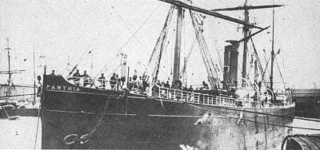
The SS Parthia (1870–1956) was an iron-hulled transatlantic ocean liner built for the Cunard Line by William Denny and Brothers in Dumbarton, Scotland. Her sister ships were the Abyssinia and Algeria. Unlike her two sisters, Parthia was smaller, built in a different shipyard and had a slightly different funnel arrangement. The Parthia was retired by Cunard in 1883 and sold to John Elder & Co., who subsequently transferred her to the Guion Line. After serving with the Guion Line and operating on transpacific routes with the Canadian Pacific Railway Company, she was refit and renamed Victoria.
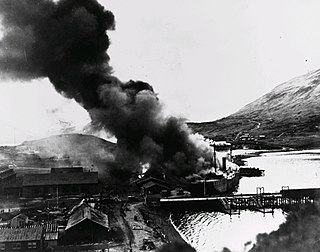
The SS Northwestern, originally SS Oriziba, was a passenger and freight steamship launched in 1889 by the Delaware River Iron Ship Building and Engine Works, Chester, Pennsylvania which spent most of its career in service in the waters of the Territory of Alaska. The ship from early in its career had a reputation for trouble, and was frequently involved in groundings, collisions with other ships, and with port facilities. She first served as a transport in the West Indies as Oriziba, and was acquired by the Northwestern Steamship Company in 1906, sailed around Cape Horn, and renamed Northwestern. For the next thirty years she worked along the Alaska coast, transporting people, mail, and goods, as well as ore from mining operations at Kennecott.
The Pacific-Alaska Navigation Company was an American passenger and freight ocean shipping company that operated between 1912 and 1916 on the West Coast of North America. It was formed as a holding company during the merger of the Alaska Pacific Steamship Company and the Alaska Coast Company. During its four years of life, its fleet became known as the Admiral Line because its ships were usually named for former U.S. Navy admirals. The company was operated by president H.F. "Bert" Alexander, a former Tacoma longshoreman who worked his way up the ranks.

